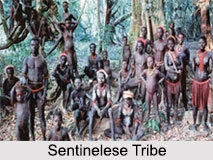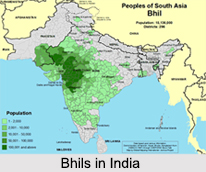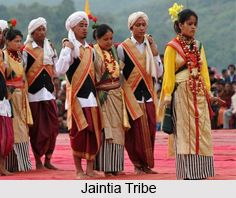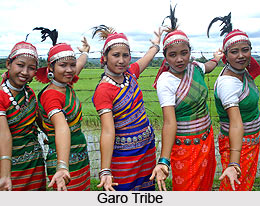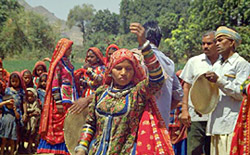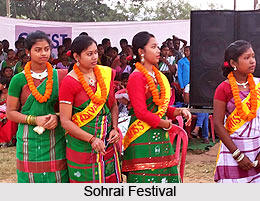 Sohrai festival is celebrated by the Munda Tribe on the fifteenth day of the month of Kartik during the Kartik amawasya i.e. in the month of October-November. The festival is specially celebrated in honour of the cattle. The Mundas also term it as Lakshmi Puja as on Sohrai day goddess Lakshmi is associated with the cattle. The reason behind it is associated with a legendary fable.
Sohrai festival is celebrated by the Munda Tribe on the fifteenth day of the month of Kartik during the Kartik amawasya i.e. in the month of October-November. The festival is specially celebrated in honour of the cattle. The Mundas also term it as Lakshmi Puja as on Sohrai day goddess Lakshmi is associated with the cattle. The reason behind it is associated with a legendary fable.
Legend of Sohrai Festival
According to it after the creation of the earth God sent Lakshmi to give a message to the Mundas that they must take their bath everyday and meal once a week. It was done as God had difficulty in providing every Munda with sufficient corn for his daily use. Goddess Lakshmi after coming down to the earth urged all the Mundas to assemble to hear the message. However, while pronouncing the message she put it in a wrong way saying that the God has directed them to take their meal everyday and bathe once a week. Later she returned to her abode. When God summoned her to inquire whether she had communicated the message to the Mundas, the goddess regretfully expressed that she had communicated the message in the reverse way. This infuriated the God and in a fit of anger he asked her from where he would procure this huge quantity of corn to feed the Mundas everyday. He thus cursed her that once in a year she must she must harness in their ploughs instead of oxen in order to produce a golden harvest.
Celebration of Sohrai Festival
On the occasion of the Sohrai the Mundas believe that the goddess Lakshmi is being harnessed in their ploughs in the guise of the cattle, and hence they treat the cattle with great respect and reverence. They do not engage them in any work for seven days before the Sohrai festival. The most appreciable thing in this connection is the love and reverence for the cattle. They feel a sense of oneness with the animals. They decorate them, give them delicious food, do not beat with, on the other hand worship them and do not engaged them in any work.
The long programme for eight days is listed down for the celebration of Sohrai festival. The Mundas are prohibited from harnessing the cattle in the ploughs or from engaging them in any work for a week prior to the Sohrai festival. The last three days preceeding the festival are reserved for days of the cattle as during that time they are thoroughly washed, cleaned and anointed with oil, generally of Surguja (Guizotia abyssinica) and of Kujuri (celastrus panien lata). The horns, foreheads and necks of the cattle are particular cleaned and other organs in general are massaged with the oil. Their sheds are cleaned, washed, plastered with cow dung and the damages are also repaired. On all the three days a clay lamp with surguja oil in it is lit in the cowshed or just at the door. A pole of Mahua (bassia latifolsa) is fixed at the spot, bifurcated into two for a small distance from above, clay placed over its head and the clay lamp is lit thereupon.
On the festive day the complete village is bathed in joy, merriment and gusto. With the first rays of the sun the cattle are let loose to graze in the fields and are not taken back until afternoon. In this festival sacrifice is offered in the name of Gorea. Hence a pole of Madukam (bassia latifolia) is fixed in front of the cowshed that identifies the Gorea to it. The Mundas in their own dialect name this pole as Gorea Khunta or Gorea Kunta. The head of the family or any other male member of the house entrusted to offer sacrifice first takes his bath and upon returning he draws some sketches around the Gorea Khunta with rice flour diluted with water. Two parallel lines almost 8" cms apart are drawn from the Gohal (cowshed) to the Gorea khunta. These lines are drawn in a way that they meet a big circle with a square circumscribing it. Two diameters pointing towards the north-south and west-east are drawn inside the circle. Four smaller circles are inscribed in the four quadrants, one in each. Small circles are also drawn on each of the two parallel lines that act as their diameters. These small circles as well as the four circles inside the four quadrants of the bigger circle symbolize the hoofs of the cattle. These circles are again circumscribed by another circle drawn with vermilion lA" apart. The figure drawn represent that the cattle have started from the Gohal and have resided in the Gorea Khunta. At noon the cattle are taken to the cowshed where they are allowed to rest. A garland is made by the head of the family who plucks some flower, generally of marigold and some paddy couch-grass.
He also wears a sacred thread, dyed with turmeric and couch-grass attached to it at four or five different places. Then taking a windowing fan, a knife, arwa rice, couch grass, a few clay lamps, surguja oil, vermilion, rice flour and, a red and a black fowl the rituals are initiated. The head of the family washes his hands and feet, makes three heaps of rice before the Gorea Khunta and places three leaf cups before them. In one he places rice, in another cup vermilion and in the third some beer. The Gorea Khunta is then smeared with plaster of rice flour and vermilion. The fowl are made to eat something while the head utters the following sacrificial hymn
"He Gaigorea, Baisigorea sironaruasre Sirma Kutuiulre,
tisindoin, Seoajad, Sarajadmeain Omaontanain,
Cedamtanan, Srunaryar Sirma Kutil sui hara diuri gai sutu
urunm gongoraderkom. Kanda Kantasad jomtan, nutanre,
merakodigo merako deogo, pirire kusurire birre Kandar
re, huan banoka baear sodor banoka, hota bunum kako
dalpatara-kako harsanda Kako, sinsufa dadusubare anna
mokako turnamokako. Miuenga Meromenga, guti sera
guti sukurileka poaakan posa akan kako".
"O Gorea of the cows, Gorea of the buffaloes. After a year, the date having come back, today I worship and invoke thee, and give and offer thee a sacrifice. During the whole year thou hast protected the ploughing and breeding cattle in their going out and in their coming back. Protect them O friend, next year, when they drink blackish water and eat grass as tasty as if seasoned with salt, let nothing stick in their throat, on the high lands and in the jungles let them not fall in any pit and not get splinters in their feet, let them not be attacked by tigers or beaten by snakes; let them belabour with their horns the white ants` hills and the bushes (i.e. be fall of life) and may the bulls run after the cows; when they remain outside at night let them be found safe under the trees at d awn. Let the cow kind and the goat kind increase like the small kind of baboons and like the small kind of swine."
The fowl is beheaded with a knife or sickle after the end of this formula. The blood oozing out of the beheaded fowl is dropped on the cattle, the Gorea Khunta and the three heaps of rice, followed by a libation of the ritual rice beer. After the completion of the sacrifice the meat of the fowl is prepared along with rice. Three leaf cups with meat in them are taken which are placed before the Gorea Khunta. Sometimes Khichari i.e. rice and pulse boiled together is also prepared by them. The members of the family consume the food prepared and also feed the cattle.
After taking rest the cattle are taken out of the cowshed where they are once again anointed with oil, garland, their horns, foreheads and other parts being smeared with rice flower, diluted with water and with vermilion. The adornment of the cattle exhibits the respect, love and reverence of the Mundas towards them. Their horns are adorned with crowns of green paddy and garlands sewn with grass fibre that are hung around their neck. The Mundas then worship them with arwa rice, couch-grass flowers and clay lamps. This is called the `Bhainsi Chuman` i.e. the benedictory kissing of the buffaloes. Their head, chest, hands etc. are also plastered by the villagers with a paste of rice flour. Men and women besmear each other with this paste. Green paddy, couch grass etc. are fastened in their sacred threads, hairs and cloths. The cattle are now let loose and are driven by the villagers follow by beating of drums and other musical instruments. They are driven for about two hours in almost all the lanes and bye lanes of the village. During this time the villagers engage in snatching the garlands and the crowns of green paddy that are hung around the cattle`s neck. It is done to procure them as a guard against evil eyes, as they are believed to be endowed with some magical virtues.
Before night the cattle return to their respective sheds. The elders of the village rejoice among themselves consuming cup of beer and the youngsters go from door to door collecting oil. With the collected oil they light the lamps in their house, cattle sheds, fields and Sarna. The cowherd who took care of the cattle throughout the year is entertained with a good cup of beer. For a complete week the village is submerged into mirth, merriment and festivity.
In some villages it lasts even up to the third or the fourth day after the festival. The festival is invariably celebrated on the same day in all the villages. It is on this festival day that the villagers drink to their fullest. For this they brew sufficient beer so as to continue drinking even after three or four days succeeding the main festival day. On the day following of the Sohrai villagers besmear each other with a plaster of rice flour.
A duel is also organised with the accompaniment of drums. During the afternoon hour on the third day the villagers plant the Karam in the village Akhara. A thick bamboo is plated in the centre of the village. This bamboo pole is divided into eight parts from above, leaving a small height from the ground and is fixed in eight poles dug in a circular way. Plantain leaves, mango leaves and other specimens of the village art are fastened with these poles. The Karam is also planted in the centre. The villagers then depart for their dinner. Later at bight they assemble at the Karam and dance and sing around the Karam for the whole night. This merriment lasts till the afternoon of the fourth day when they finally disperse.
This festival of the Munda Tribe seems to an imitation of the cow worship and the Diwali of the Hindus.

















